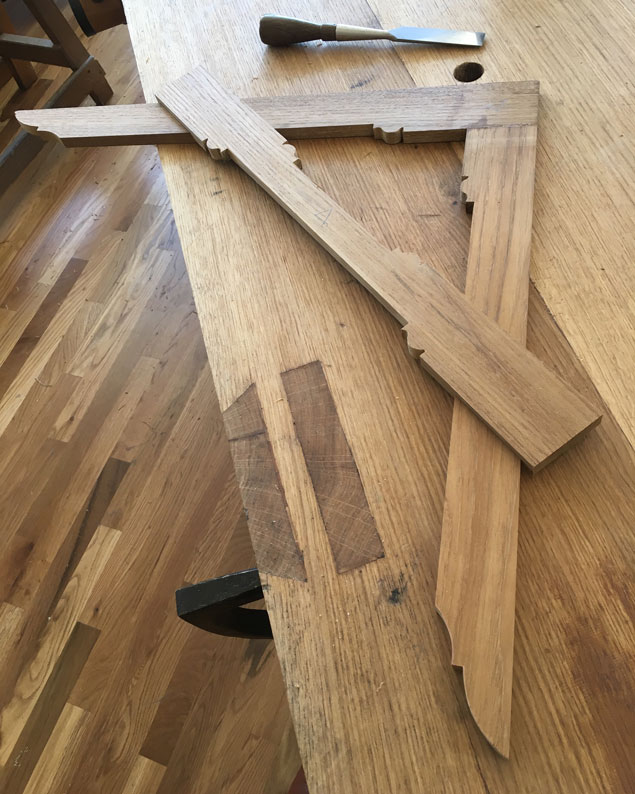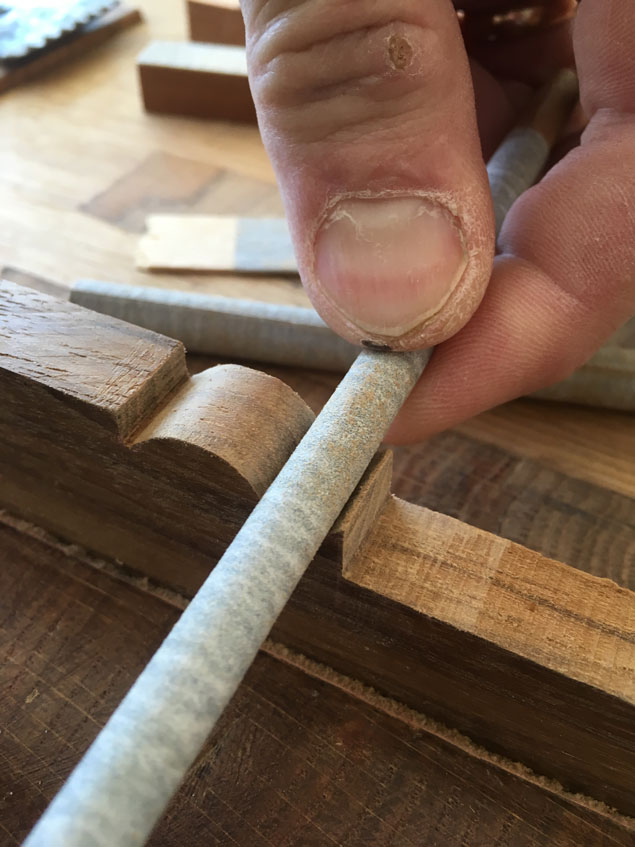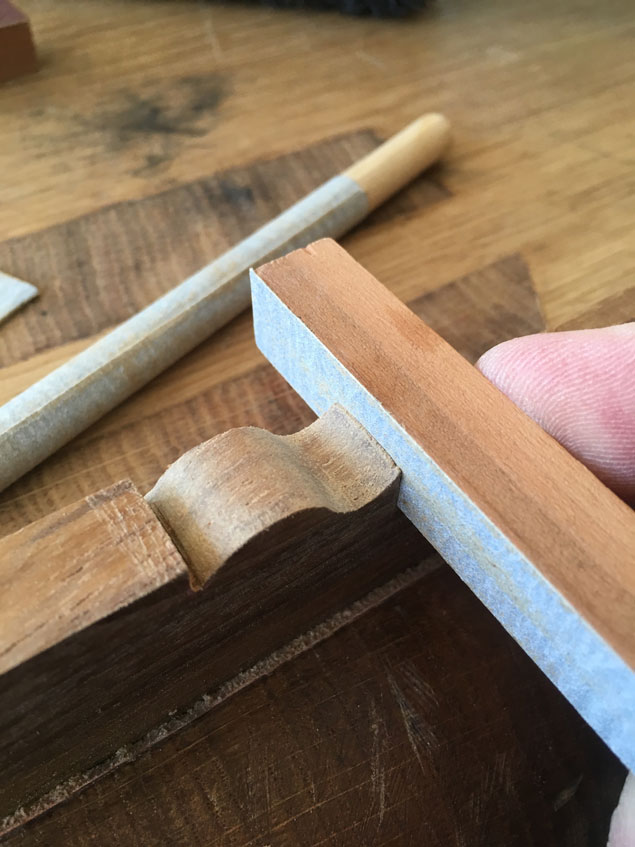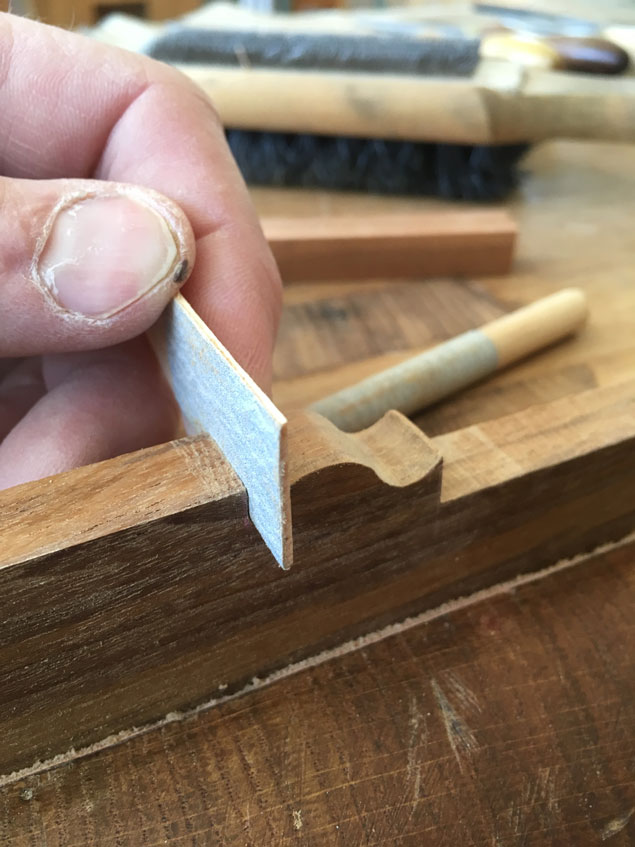We may receive a commission when you use our affiliate links. However, this does not impact our recommendations.
For curved and sculptural work, nothing beats a good rasp. But there are many times that I need to do precise and fine work that most rasps aren’t capable of (at least the rasps I’ve seen or can afford).
So I make my own custom sanding sticks using sticky-back sandpaper from the home center plus some dowels and scraps.
Today I’m finishing up an English Layout Square for a customer and had to make up a new set of sanding sticks. Somehow my previous set failed to make the move to my new workshop.
You can of course make any special shapes you need, but here are the ones I find most useful.
I wrap a 1/4” and 3/8” dowel in sandpaper to work inside curves and round shapes. These work like a rattail rasp, but you can make them with a fine abrasive – here I’m using #220-grit – to produce a ready-to-finish surface.
Using a dowel is much preferable to rolling the sandpaper into a tube to sand round shapes. A sandpaper tube will deflect in the center creating an edge that bellies in the middle. Plus the paper wears out faster.
The second shape is a 1/2” x 1/2” x 6” stick with sandpaper stuck to one of its faces. This stick works like a file with a “safe edge” – it allows you to true one surface at 90° to an adjacent one. This is handy at corners such as this bead on the layout square. I want to sand the end grain but I don’t want to touch the face grain below.
The last handy shape is a thin rectangle – about 1/16 x 3/4” x 1-1/2”. This little guy gets into crevices that rasps can’t get to. Plus it has just a little flexibility, which makes it nice for shaping small outside curves.
While I usually use #220-grit paper for these sanding sticks, I also make some up with #100- or #120-grit paper for when I need to work curves right after sawing them without rasping them.
Keep them clean – I dust them with a stiff brush – and they will last a surprisingly long time. I had my last set for almost two years.
— Christopher Schwarz
You can buy plans for the square here. Read more about the history, construction and use of this square with these previous blog entries.
Here are some supplies and tools we find essential in our everyday work around the shop. We may receive a commission from sales referred by our links; however, we have carefully selected these products for their usefulness and quality.














While I definitely believe the square being referenced is beautiful, the sheer volume of folks extolling its usefulness is a bit of a puzzlement for me.
Where it to constructed without the inside corner embellishments, two additional complementary (and rather useful!) angles would suddenly be available.
While I truly respect the author and his impressive body of work, I’m not really sure why he chose to blow away that functional option. Instead, he added those beautiful, but obstructive (and utterly useless) inside corner frills.
I’m sorry to say, in a small but often busy shop such as mine, we cannot afford essentially uni-taskers that offer just a 90 degree measurement, but look cool on the wall. I’m sure I just don’t “get it’s coolness”.
(Somehow, the story of a king’s nudity which no one chooses to see, springs to mind …)
While I have, and will continue to make the sandpaper version, i’ll try and direct you to the Iwasaki rasp. Built much like a float the fine and course versions do well to remove material,as if planed from the surface of the wood. Leaves a fine finish and doesn’t cut on the edge. A lower budget tool that out performs many more expensive ones.
I find that rifflers of various coarsenesses can do the job.
I also use various sizes of PVC pipe.
fids like these are in constant use in my shop. Since the subject’s come up, a couple other possibilities to add.
I think most people bypass the idea of using files for this sort of work as well. Most metal files work quite well on wood – though much better on hardwoods than soft.
And since I’m baring all my trade secrets – vixen files. A good vixen (sometimes called parallel tooth files) is basically a float, only with harder and slightly sharper teeth. They are SPECTACULAR in shaping and smoothing hard woods.